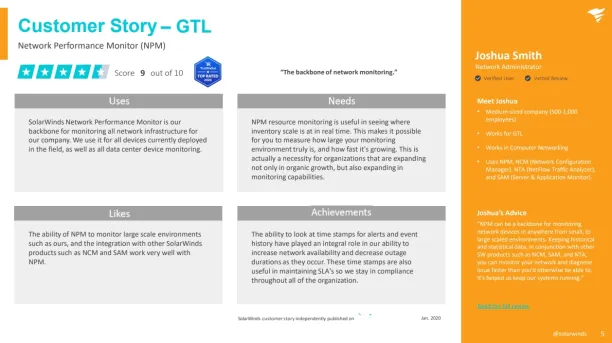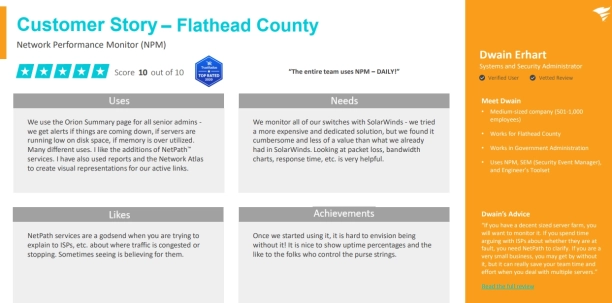Top 6 Network Monitoring Use Cases in 2024
Effective network monitoring stands as a cornerstone of efficient IT management. As businesses increasingly rely on complex networks to support their operations, the need for robust monitoring solutions becomes paramount. By employing a range of tools and methodologies, network monitoring empowers organizations to manage their network performance, identify potential issues, and maintain optimal functionality.
This article explores the diverse network monitoring use cases, highlighting its importance and impact across different scenarios.
Core Network Monitoring Use Cases
1. Performance Optimization
Monitoring network performance is crucial for identifying bottlenecks and inefficiencies. By analyzing traffic patterns and bandwidth utilization, organizations can make informed decisions about network upgrades and configuration changes, ensuring optimal performance and avoiding unnecessary expenditures.
Case Study 1
GTL, a medium-sized company with 500-1,000 employees, utilizes the SolarWinds Network Performance Monitoring tool for their network management needs. NPM resource monitoring provides real-time visibility into inventory scale, enabling measurement of the size and growth rate of the monitoring environment. This capability is indispensable for organizations expanding not only organically but also in terms of their monitoring capabilities. 1

2. Security Threat Detection
Network monitoring tools are critical in the early detection of security threats. By continuously analyzing network traffic, these tools can identify unusual activities that may indicate a security breach, such as unauthorized access or the spread of malware.
Case Study 2
NTT migrated to the LogicMonitor platform for automated hybrid infrastructure monitoring and analytics, integrating with their CMDB for enhanced visibility across all environments. The deployment process was easy, utilizing APIs for automation. LogicMonitor’s bi-directional integration with the ServiceNow CMDB simplified monitoring tasks and improved operational efficiency, allowing for quicker onboarding of new technologies and devices. The solution provided enabling NTT to accelerate customer migrations and improve business agility without the need for maintaining legacy components.2.
3. Compliance and Audit
For businesses that are subject to regulatory requirements, network monitoring provides the necessary tools to ensure compliance. This includes tracking data flows, monitoring access controls, and logging user activities to create audit trails.
Case Study 3
One real-life example of network monitoring aiding compliance and audit processes is the case of Equifax, a consumer credit reporting agency. In 2017, Equifax suffered a massive data breach compromising the personal information of over 147 million individuals. Following the breach, Equifax faced intense scrutiny from regulatory bodies such as the U.S. Securities and Exchange Commission (SEC) and the Consumer Financial Protection Bureau (CFPB). These agencies required Equifax to demonstrate robust security measures and compliance with data protection regulations. Equifax implemented network monitoring solutions to enhance their security posture and ensure compliance with regulatory requirements. These tools allowed Equifax to track data flows, monitor access controls, and log user activities across their network infrastructure.3.
4. Troubleshooting and Diagnostics
When network issues arise, a robust network monitoring system helps in quickly pinpointing the source of the problem. This rapid diagnosis minimizes downtime and facilitates swift recovery, thereby reducing the impact on business operations.
Case Study 4
Netskope, a provider of security services, relies on the Kentik Network Intelligence Platform for troubleshooting and diagnostics in its global NewEdge Network. Facing the challenge of monitoring a complex network environment, Netskope turned to Kentik’s flow monitoring capabilities to gain critical visibility into traffic flows. By leveraging Kentik’s insights, Netskope optimized peering relationships, identified traffic anomalies, and achieved cost savings through accurate billing and service contract optimizations. The analysis of network performance yields actionable insights that empower businesses to select optimal peering partners, efficiently route traffic, and help customers maximize their utilization of internet services. 4.
Case Study 5
SPI Health and Safety, a leading Canadian provider of health and safety solutions, transitioned all call center employees to remote work during the onset of the 2019 pandemic to maintain service continuity while prioritizing staff safety. However, ensuring optimal network and VoIP performance for remote workers posed a challenge. Complaints regarding poor VoIP quality during support calls emerged, impacting customer satisfaction. To address this, SPI Health and Safety adopted Obkio Network Performance Monitoring software. This solution enabled them to monitor network and VoIP performance, swiftly identify issues, and gather data for troubleshooting, thereby ensuring uninterrupted service delivery and enhancing customer experience. 5.
5. Capacity Planning
By regularly monitoring network usage and performance, IT teams can predict future network needs. This approach to capacity planning helps in scaling network resources efficiently, aligning them with business growth and demand.
Case Study 6
Blue State Digital (BSD), a provider of web, email, and fundraising platforms, faced challenges in monitoring their rapidly expanding infrastructure, especially with the implementation of a “next generation” action tracking service. To streamline monitoring, BSD turned to Datadog for its automated setup capabilities and integration with their existing systems. Datadog’s push-driven metric collection and easy integration with StatsD allowed BSD to gather metrics effortlessly, even from esoteric sources like HAProxy and ElasticSearch. The platform’s timeline view and tagging features further enhanced BSD’s operations by simplifying data manipulation and incident management. 6
6. Quality of Service (QoS) Management
Network monitoring tools enable administrators to prioritize network traffic and ensure that critical applications receive the necessary bandwidth. This is especially important in environments where network resources are shared among numerous applications and services.
Case Study 7
A medium-sized company with 501-1,000 employees, operating for Flathead County, utilizes SolarWinds Network Performance Monitor (NPM) and Engineer’s Toolset for network management. The Orion Summary page serves as a central hub for senior administrators, providing real-time alerts for impending issues such as server downtimes, low disk space, and memory overutilization. The company leverages SolarWinds’ reporting features and Network Atlas for visual representations of active links, ensuring efficient monitoring of all switches. The tool’s ability to showcase uptime percentages proves invaluable in financial discussions, solidifying its status as an indispensable asset for network management within the organization. 7.

FAQ
How does network monitoring contribute to performance optimization?
Network monitoring tools provide real-time insights into network traffic, bandwidth utilization, and device performance. By analyzing this data, organizations can identify areas of congestion, optimize network configurations, and allocate resources efficiently to enhance overall performance.
How does network monitoring help enhance security?
Network monitoring use cases employ advanced threat detection algorithms and anomaly detection techniques to identify suspicious activities, malware infections, and unauthorized access attempts. By continuously monitoring network traffic and behavior, organizations can detect security threats early and respond promptly to prevent data breaches and cyber attacks.
Can network monitoring tools assist with compliance and audit requirements?
Yes, network monitoring tools play a crucial role in ensuring compliance with regulatory requirements by tracking data flows, monitoring access controls, and logging user activities. By maintaining comprehensive audit trails, organizations can demonstrate compliance during regulatory audits and inspections.
How does network monitoring support capacity planning initiatives?
Network monitoring tools provide valuable insights into network usage patterns, traffic trends, and performance metrics, enabling organizations to forecast future capacity requirements accurately. By proactively planning for increased demand, organizations can avoid network congestion, optimize resource allocation, and ensure seamless scalability.
For more on network monitoring
- Top 5 Network Monitoring Tools in Windows in 2024
- Top 4 AI Network Monitoring Use Cases and Real-Life Examples in ’24
- Top 7 Free Network Monitoring Tools based on 1,000+ Reviews in 2024
- Top 10 Network Monitoring Best Practices in 2024
External Links
- 1. “SolarWinds NPM Customer Stories”. Accessed: April 30 2024.
- 2. “NTT Enhances Network Insight by Integrating LogicMonitor with ServiceNow CMDB”. Accessed: April 30 2024.
- 3. “Case Study: Equifax Data Breach”. Accessed: April 30 2024.
- 4. “Netskope Peers Deeply into its Network with Kentik”. Accessed: April 30 2024.
- 5. “Network Monitoring and Troubleshooting for Remote Workers with SPI Health and Safety”. Accessed: April 30 2024.
- 6. “The Need: Monitoring To Scale Effortlessly Alongside a Growing Enterprise”. Accessed: April 30 2024.
- 7. “SolarWinds NPM Customer Stories”. Accessed: April 30 2024.

Cem is the principal analyst at AIMultiple since 2017. AIMultiple informs hundreds of thousands of businesses (as per Similarweb) including 60% of Fortune 500 every month.
Cem's work has been cited by leading global publications including Business Insider, Forbes, Washington Post, global firms like Deloitte, HPE, NGOs like World Economic Forum and supranational organizations like European Commission. You can see more reputable companies and media that referenced AIMultiple.
Throughout his career, Cem served as a tech consultant, tech buyer and tech entrepreneur. He advised enterprises on their technology decisions at McKinsey & Company and Altman Solon for more than a decade. He also published a McKinsey report on digitalization.
He led technology strategy and procurement of a telco while reporting to the CEO. He has also led commercial growth of deep tech company Hypatos that reached a 7 digit annual recurring revenue and a 9 digit valuation from 0 within 2 years. Cem's work in Hypatos was covered by leading technology publications like TechCrunch and Business Insider.
Cem regularly speaks at international technology conferences. He graduated from Bogazici University as a computer engineer and holds an MBA from Columbia Business School.
Sources:
AIMultiple.com Traffic Analytics, Ranking & Audience, Similarweb.
Why Microsoft, IBM, and Google Are Ramping up Efforts on AI Ethics, Business Insider.
Microsoft invests $1 billion in OpenAI to pursue artificial intelligence that’s smarter than we are, Washington Post.
Data management barriers to AI success, Deloitte.
Empowering AI Leadership: AI C-Suite Toolkit, World Economic Forum.
Science, Research and Innovation Performance of the EU, European Commission.
Public-sector digitization: The trillion-dollar challenge, McKinsey & Company.
Hypatos gets $11.8M for a deep learning approach to document processing, TechCrunch.
We got an exclusive look at the pitch deck AI startup Hypatos used to raise $11 million, Business Insider.
To stay up-to-date on B2B tech & accelerate your enterprise:
Follow on


Comments
Your email address will not be published. All fields are required.